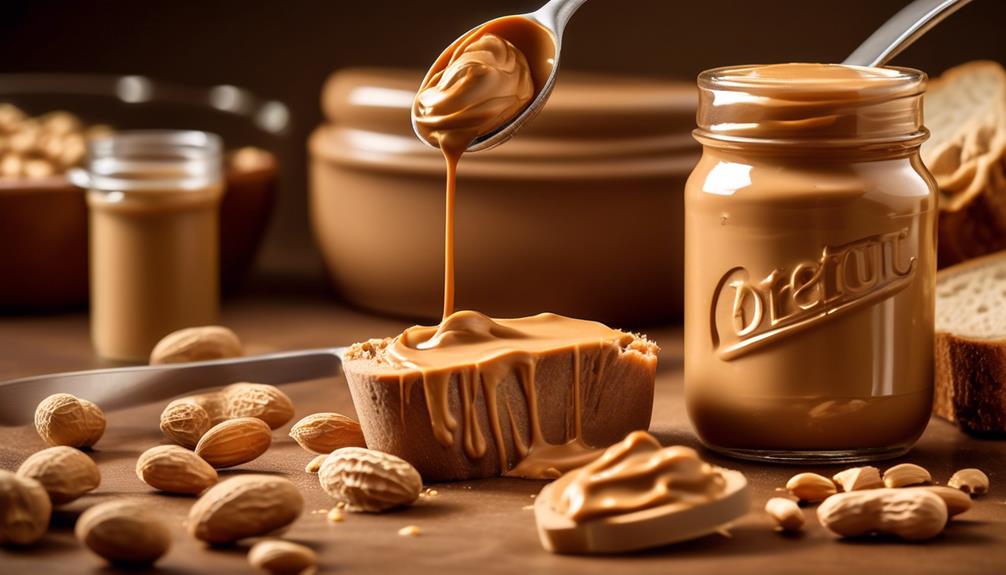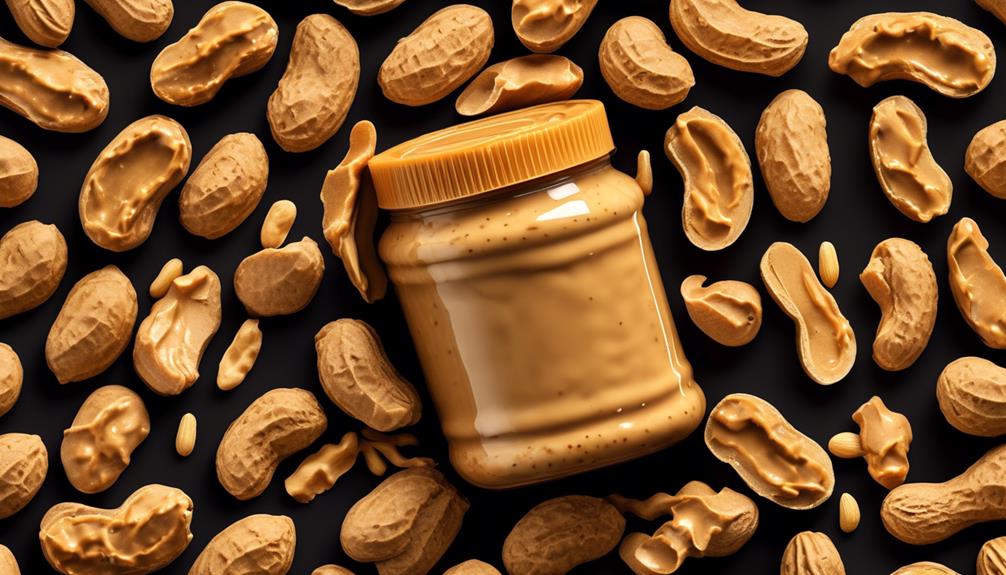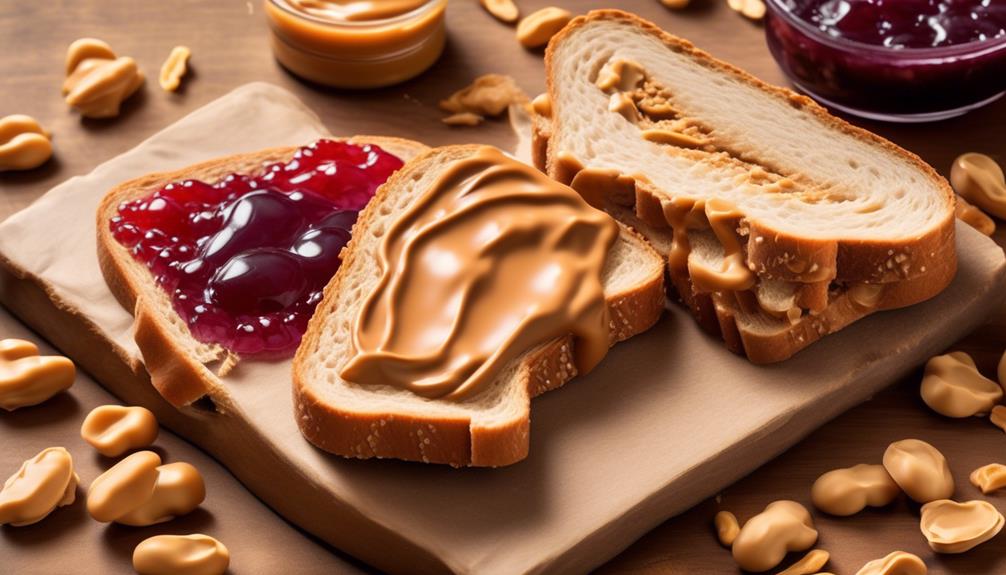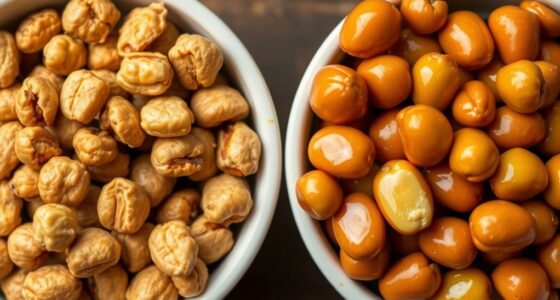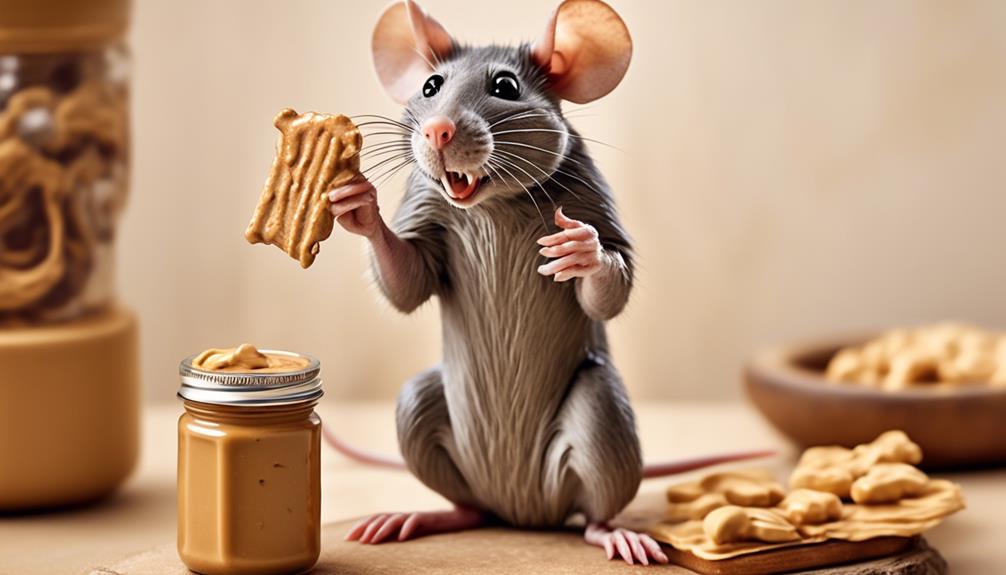When it comes to peanut butter, 2 tablespoons may not seem like a lot, but it’s important to consider the impact it can have on your diet. While we may have a general idea of what a serving size should be, have you ever taken a moment to truly reflect on what that translates to in terms of calories, nutrients, and its contribution to your overall nutrition?
Understanding the true nature of 2 tablespoons of peanut butter can shed light on how it fits into your daily diet and its potential benefits or drawbacks. So, what exactly does this small serving size entail, and how does it affect your health and wellness?
Key Takeaways
- Portion control is important when consuming peanut butter to manage caloric intake and align with dietary goals.
- Two tablespoons of peanut butter contain 180 calories, 15g of fat, 16% carbohydrates, and 4.5g of protein.
- Accurate measurement of 2 tablespoons of peanut butter is crucial for maintaining nutritional integrity and tracking macros.
- Peanut butter can be incorporated into a balanced daily diet by spreading it on bread, adding it to oatmeal or yogurt, using it as a dip for fruits, or blending it into smoothies.
The Importance of Portion Control
Understanding the importance of portion control is crucial for managing caloric intake and maintaining a healthy weight. When it comes to foods like peanut butter, being mindful of portion sizes is especially important. Just two tablespoons of peanut butter contain around 190 calories, making it a calorie-dense food. Without proper portion control, it's easy to consume more calories than intended, which can lead to weight gain over time.
By practicing portion control, we can enjoy the delicious taste of peanut butter while still aligning with our dietary goals. It's not about depriving ourselves but rather about being aware of how much we're consuming. Portion control allows us to savor a variety of foods in moderation, promoting a balanced nutrient intake and overall well-being.
Moreover, monitoring portion sizes can enhance our awareness of nutritional intake, promoting mindful eating habits. This can help prevent overeating and reduce the risk of weight-related health issues. By understanding portion control and applying it to our daily food choices, we can better manage our caloric intake and support a healthy lifestyle.
Caloric Content of 2 Tablespoons

Being mindful of portion sizes, especially with calorie-dense foods like peanut butter, is crucial for managing our caloric intake and maintaining a healthy weight. When we consume 2 tablespoons of peanut butter, we're taking in 180 calories, making it essential to be conscious of our serving sizes.
Here's why the caloric content of 2 tablespoons of peanut butter matters:
- High Caloric Density: 2 tablespoons of peanut butter contain 180 calories, making it important to measure our servings to avoid unintentionally consuming excess calories.
- Macronutrient Distribution: These 2 tablespoons consist of 15g of fat, 16% carbohydrates, and 14% protein. Understanding this breakdown can help us balance our overall macronutrient intake.
- Protein Contribution: This serving provides 4.5g of the daily recommended intake of protein, supporting muscle repair and overall body function.
- Physical Activity Equivalent: To burn off the 180 calories from 2 tablespoons of peanut butter, a certain amount of cycling or running is required. Understanding this can help us make informed decisions about our calorie consumption and physical activity levels.
Being aware of the caloric content of 2 tablespoons of peanut butter empowers us to make informed choices about our dietary intake and overall health.
Nutritional Profile of 2 Tablespoons

We can gain valuable insight into the nutritional profile of 2 tablespoons of peanut butter by examining its caloric content, macronutrient composition, and suitability for tracking macros.
A serving of this food provides 180 calories, making it a substantial source of energy. It contains 15g of fat, constituting 72% of the total content. While this may seem high, it's important to note that the majority of the fat in peanut butter is unsaturated, which can be beneficial for heart health when consumed in moderation.
The carb content is relatively low, making up 16% of the Daily Value (DV), and it offers 4.5g of protein, contributing 14% of the DV. This balance of macronutrients makes peanut butter a versatile choice for those looking to manage their macros, especially for individuals following a low-carb or high-fat diet.
Additionally, the serving size is suitable for tracking macros using tools like MyFitnessPal, making it easier for individuals to monitor their nutritional intake accurately.
Visual Representation of 2 Tablespoons

When it comes to understanding portion sizes, seeing is believing. Visualizing the amount of peanut butter that constitutes 2 tablespoons can help us better grasp its caloric and nutritional impact.
Serving Size Illustration
Providing a visual representation of 2 tablespoons of peanut butter can help individuals better understand and adhere to the recommended serving size. To illustrate this serving size effectively, consider these practical ideas:
- Use a standard measuring spoon to scoop out 2 tablespoons of peanut butter.
- Spread the measured peanut butter on a slice of bread to visualize the portion size.
- Compare the 2 tablespoons to the size of a ping pong ball or a golf ball for a quick visual reference.
- Place the peanut butter in a small bowl to see the actual volume and better gauge the serving size.
Understanding the appropriate serving size of peanut butter is crucial for integrating it into a balanced daily diet while being mindful of calorie and fat intake.
Portion Control Demonstration
Demonstrating the visual representation of 2 tablespoons of peanut butter is an effective way to illustrate the recommended serving size and facilitate portion control. When we see what 2 tablespoons of peanut butter looks like, it becomes easier to manage our portions.
This visual aid is especially helpful because peanut butter is calorie-dense, and a serving of food contributes significantly to our daily intake. By understanding what 2 tablespoons of peanut butter looks like, we can better manage our calorie intake and maintain a balanced diet.
It also helps us grasp the fat, protein, and carbohydrate content in this serving size, which is crucial for dietary management. This demonstration, therefore, plays a significant role in helping us make informed choices and maintain portion control for better overall health.
Using 2 Tablespoons in Recipes

When it comes to using 2 tablespoons of peanut butter in recipes, it's important to consider the impact it has on the overall measurement.
We'll explore how this amount can affect the texture and flavor of various dishes, from smoothies to sauces.
Additionally, we'll compare the nutritional content of recipes using this specific quantity of peanut butter and discuss the benefits it brings to the table.
Measurement in Recipes
How can we accurately measure two tablespoons of peanut butter in recipes to ensure the correct serving size and nutritional content? When incorporating 2 tablespoons of peanut butter into recipes, it's crucial to measure accurately. Here's how to do it:
- Use a measuring spoon specifically designed for tablespoons to accurately portion the peanut butter.
- Level the peanut butter in the measuring spoon using a straight edge to ensure an exact measurement.
- Consider using a kitchen scale for even more precise measurements, especially in baking.
- To make the peanut butter easier to measure, try spraying the measuring spoon with non-stick cooking spray before scooping the peanut butter.
Ensuring accurate measurements won't only help control portion sizes but also maintain the nutritional integrity of the recipe.
Nutritional Content Comparison
Looking to compare the nutritional content of different peanut butter brands when using 2 tablespoons in recipes? It's essential to consider the nutritional content of peanut butter, especially when using it in recipes.
Two tablespoons of peanut butter typically contain around 180-200 calories, 12-16 grams of fat (mostly healthy unsaturated fats), 6-8 grams of protein, and 2-4 grams of sugar. When incorporating peanut butter into recipes, these values can significantly impact the overall nutritional composition of the dish.
It's crucial to check the labels of different peanut butter brands for variations in nutritional content, including added sugars, salt, and other ingredients. This comparison can help you make informed choices about which peanut butter to use based on your dietary preferences and nutritional goals.
Spreading on Bread
Considering the nutritional content of different peanut butter brands, it's important to explore the versatility of using 2 tablespoons in recipes, such as spreading on bread for a flavorful and satisfying snack or meal addition.
When spreading 2 tablespoons of peanut butter on bread, there are a few key points to keep in mind:
- Provides about 180 calories
- Offers a balanced mix of carbohydrates, fats, and protein
- Adds a rich and nutty flavor to the bread
- Consider complementing it with sliced fruits or a drizzle of honey for added flavor and nutrients
Spreading 2 tablespoons of peanut butter on bread not only creates a delicious and quick snack but also provides essential nutrients.
Remember to be mindful of portion sizes, as peanut butter can quickly add up in calories and fat content.
Comparison With Other Nut Butters

When comparing peanut butter to other nut butters, it stands out as a good source of protein and healthy fats. In a 2-tablespoon serving, peanut butter contains 4.01g of protein, 180 calories, 15g of fat, and 16% of carbohydrates. Let's compare these nutritional values with other popular nut butters:
| Nut Butter | Protein (g) | Calories | Fat (g) | Carbohydrates |
|---|---|---|---|---|
| Peanut Butter | 4.01 | 180 | 15 | 16% |
| Almond Butter | 3.38 | 196 | 18 | 6% |
| Cashew Butter | 2.61 | 188 | 15 | 12% |
| Sunflower Butter | 6.75 | 200 | 16 | 7% |
From the comparison, it's evident that while each nut butter offers its own unique benefits, peanut butter stands out for its balanced nutritional profile. It provides a good amount of protein and healthy fats, making it a valuable addition to a weight-conscious or health-conscious diet. When considering weight management and maintaining a balanced diet, incorporating peanut butter can be a beneficial choice.
Health Benefits of 2 Tablespoons

We've found that 2 tablespoons of peanut butter pack a powerful punch when it comes to essential nutrients like protein, healthy fats, and fiber. These nutrients not only contribute to a balanced diet but also serve as a valuable energy source.
Additionally, the protein content in 2 tablespoons of peanut butter can aid in weight loss by increasing feelings of fullness and curbing appetite.
Nutrient Content
Peanut butter, in just two tablespoons, offers a substantial amount of nutrients and can be beneficial for overall health when consumed in moderation. When considering the nutrient content, it's important to note that two tablespoons of peanut butter contain 180 calories. This serving size also provides 15g of fat, which makes up 72% of the total calories, and 4.01g of protein, contributing to 14% of the calories.
Additionally, peanut butter is a good source of essential nutrients such as potassium, calcium, and iron. Consuming peanut butter in moderation can aid in weight loss and appetite reduction. It's essential to consider the overall nutrient content and calorie intake when incorporating peanut butter into a balanced diet, aiming for around 2,000 to 2,500 calories a day.
Energy Source
Considering the nutrient-dense nature of peanut butter and its potential benefits for weight management, it's important to explore the energy-providing health benefits offered by just 2 tablespoons of this popular spread.
Two tablespoons of peanut butter provide around 180 calories, making it an excellent energy source. The combination of healthy fats, protein, and fiber in peanut butter offers a sustained release of energy, making it a great option for fueling your day.
This energy boost can support physical activity, cognitive function, and overall vitality. Additionally, the nutrient profile of peanut butter, including vitamins E, magnesium, and potassium, further contributes to its role as an energy powerhouse.
Risks Associated With Excessive Intake

Excessive intake of peanut butter can lead to weight gain and an increased risk of cardiovascular disease due to its high calorie, fat, and saturated fat content. It's essential to be mindful of portion sizes, as overconsumption may have adverse effects on our health.
Here are some risks associated with excessive intake:
- Weight Gain: Peanut butter is calorie-dense, and consuming large amounts can contribute to weight gain, especially if not accounted for within a balanced diet.
- Cardiovascular Disease: The high saturated fat content in peanut butter can elevate cholesterol levels, increasing the risk of heart disease if consumed excessively.
- Inflammation: Overconsumption of peanut butter can lead to excessive intake of omega-6 fatty acids, potentially contributing to inflammation in the body.
- Nutrient Imbalance: Excessive peanut butter consumption may lead to imbalances in essential vitamins and minerals, affecting overall health.
Being mindful of portion sizes and incorporating peanut butter into a balanced diet is crucial for maintaining a healthy lifestyle. While peanut butter can be a valuable source of nutrients and healthy fats, moderation is key to avoid potential health risks.
Tips for Measuring Accurately

After discussing the potential risks associated with excessive intake of peanut butter, it's important to ensure accurate measurements when incorporating this ingredient into recipes or daily servings.
To measure peanut butter accurately, start by using a flat surface. Fill the measuring spoon completely and level it off with a straight edge for precise two tablespoons. When dealing with sticky substances like peanut butter, consider using a spatula or coating the measuring spoon with cooking spray to ensure it releases easily. Always check the measurement at eye level to guarantee accuracy.
Additionally, it's essential to use the right tools for the job. Utilize a liquid measuring cup for liquids and a dry measuring cup for dry ingredients.
Incorporating 2 Tablespoons Into Daily Diet

We can incorporate 2 tablespoons of peanut butter into our daily diet to benefit from its essential nutrients like protein, healthy fats, fiber, and vitamins.
Here are some practical ways to include this serving:
- Spread it on whole grain toast for a satisfying breakfast.
- Mix it into oatmeal or yogurt for a creamy and nutritious twist.
- Use it as a dip for apple or banana slices as a midday snack.
- Blend it into smoothies to add richness and creaminess.
Conclusion and Final Thoughts

Considering the valuable ways to incorporate 2 tablespoons of peanut butter into our daily diet, it's important to reflect on the overall impact and potential benefits of this simple addition.
Peanut butter, in this serving size, provides a convenient and delicious way to boost our nutrition. The rich blend of protein, healthy fats, and essential nutrients offers sustained energy and promotes a feeling of fullness, making it an ideal addition to meals or snacks.
The versatility of peanut butter allows for creative use in recipes, catering to diverse culinary preferences. Its potential to enhance the flavors of fruits, vegetables, and whole grains makes it a valuable staple in a balanced diet.
Frequently Asked Questions
How Do You Measure 2 Tablespoons of Peanut Butter?
We measure 2 tablespoons of peanut butter by using a measuring spoon. It's important to scoop it out level, then scrape the surface with a straight edge for accuracy. Avoid packing the peanut butter into the spoon to ensure precise measurement.
For the most precise amount, consider using a kitchen scale. It's crucial to measure accurately to ensure the success of your recipe.
What Does 2 Tablespoons Look Like?
We can tell you that 2 tablespoons of peanut butter can be visualized as two level scoops with a standard dining spoon.
It looks similar in volume to a golf ball and is roughly the size of a walnut in its shell.
This amount measures to about 1/8 of a cup, equivalent to 30 grams or approximately the size of a ping pong ball.
What Does Tablespoon of Peanut Butter Look Like?
We love the creamy texture of a tablespoon of peanut butter, resembling the smoothness of melted chocolate. This serving packs 180 calories, 15g of healthy fat, and contributes to 16% of daily carbs and 14% of recommended protein intake.
It's a nutrient-rich option full of essential nutrients. Enjoy it on toast, in smoothies, or as a dip for fruits.
This tasty serving is a delicious and nutritious addition to your diet.
Is 2 Tablespoons of Peanut Butter Too Much?
2 tablespoons of peanut butter can be excessive if not mindful of portion sizes. It packs 180 calories and is high in fat.
Moderation is key for a healthful balance. We aim to guide our audience towards informed choices for a balanced diet.
Consider trying alternatives like almond butter or PB2 for different nutritional profiles if needed. It's about finding what works best for our individual needs and goals.
Conclusion
In conclusion, it's important to practice portion control when consuming peanut butter.
Two tablespoons of peanut butter provide a good source of protein, healthy fats, and essential vitamins and minerals.
However, it's crucial to consume it in moderation due to its high calorie and fat content.
For example, adding 2 tablespoons of peanut butter to a morning smoothie can provide a satisfying and nutritious breakfast option.
Remember to measure accurately and enjoy peanut butter as part of a balanced diet.
